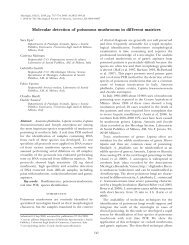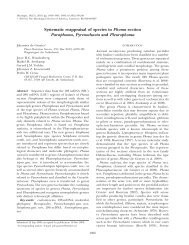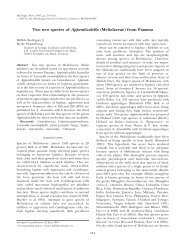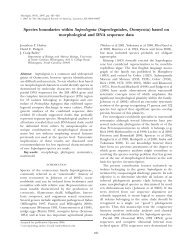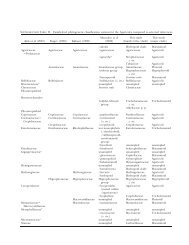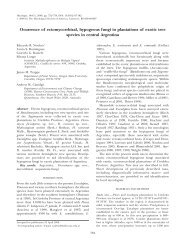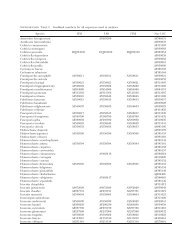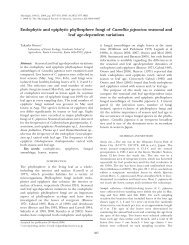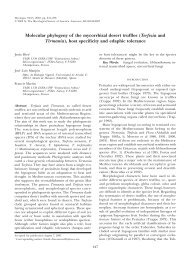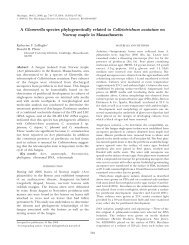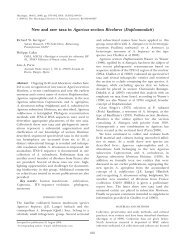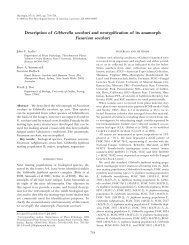A phylogenetic overview of the Agaricomycotina - Mycologia
A phylogenetic overview of the Agaricomycotina - Mycologia
A phylogenetic overview of the Agaricomycotina - Mycologia
You also want an ePaper? Increase the reach of your titles
YUMPU automatically turns print PDFs into web optimized ePapers that Google loves.
<strong>Mycologia</strong>, 98(6), 2006, pp. 917–925.<br />
# 2006 by The Mycological Society <strong>of</strong> America, Lawrence, KS 66044-8897<br />
David S. Hibbett 1<br />
A <strong>phylogenetic</strong> <strong>overview</strong> <strong>of</strong> <strong>the</strong> <strong>Agaricomycotina</strong><br />
Biology Department, Clark University, Worcester,<br />
Massachusetts 01610<br />
Abstract: The <strong>Agaricomycotina</strong> contains about onethird<br />
<strong>of</strong> <strong>the</strong> described species <strong>of</strong> Fungi, including<br />
mushrooms, jelly fungi and basidiomycetous yeasts.<br />
Recent <strong>phylogenetic</strong> analyses by P. Ma<strong>the</strong>ny and<br />
colleagues combining nuclear rRNA genes with <strong>the</strong><br />
protein-coding genes rpb1, rpb2 and tef1 support <strong>the</strong><br />
division <strong>of</strong> <strong>Agaricomycotina</strong> into Tremellomycetes,<br />
Dacrymycetes and Agaricomycetes. There is strong<br />
support for <strong>the</strong> monophyly <strong>of</strong> <strong>the</strong> Tremellomycetes,<br />
and its position as <strong>the</strong> sister group <strong>of</strong> <strong>the</strong> rest <strong>of</strong> <strong>the</strong><br />
<strong>Agaricomycotina</strong>. Dacrymycetes and Agaricomycetes<br />
also are supported strongly, and toge<strong>the</strong>r <strong>the</strong>y form<br />
a clade that is equivalent to <strong>the</strong> Hymenomycetidae <strong>of</strong><br />
Swann and Taylor. The deepest nodes in <strong>the</strong><br />
Agaricomycetes, which are supported only by Bayesian<br />
measures <strong>of</strong> confidence, suggest that <strong>the</strong> Sebacinales,<br />
Cantharellales and Auriculariales are among<br />
<strong>the</strong> most ancient lineages. For <strong>the</strong> first time, <strong>the</strong><br />
Polyporales are strongly supported as monophyletic<br />
and are placed as <strong>the</strong> sister group <strong>of</strong> <strong>the</strong> Thelephorales.<br />
The Agaricales, Boletales and A<strong>the</strong>liales are<br />
united as <strong>the</strong> Agaricomycetidae, and <strong>the</strong> Russulales<br />
might be its sister group. There are still some<br />
problematical nodes that will require more loci to<br />
be resolved. Phylogenomics has promise for reconstructing<br />
<strong>the</strong>se difficult backbone nodes, but current<br />
genome projects are limited mostly to <strong>the</strong> Agaricales,<br />
Boletales and Polyporales. Genome sequences from<br />
o<strong>the</strong>r major lineages, especially <strong>the</strong> early diverging<br />
clades, are needed to resolve <strong>the</strong> most ancient nodes<br />
and to assess deep homology in ecological characters<br />
in <strong>the</strong> <strong>Agaricomycotina</strong>.<br />
Key words: Basidiomycota, heterobasidiomycetes,<br />
hymenomycetes, phylogeny, taxonomy, Wallemia<br />
Introduction.—The <strong>Agaricomycotina</strong> is a diverse clade<br />
<strong>of</strong> Basidiomycota that includes mushrooms, jelly fungi<br />
and basidiomycetous yeasts. There are about 20 000<br />
described species <strong>of</strong> <strong>Agaricomycotina</strong>, which is 68% <strong>of</strong><br />
<strong>the</strong> known Basidiomycota, or about a third <strong>of</strong> all<br />
Fungi (Kirk et al 2001). Molecular clock studies,<br />
reviewed by Taylor et al (2004), suggest that <strong>the</strong><br />
Accepted for publication 4 September 2006.<br />
1 E-mail: dhibbett@clarku.edu<br />
917<br />
<strong>Agaricomycotina</strong> could be anywhere from 380 000 000<br />
to 960 000 000 y old.<br />
The <strong>Agaricomycotina</strong> contains large concentrations<br />
<strong>of</strong> wood decayers, litter decomposers and ectomycorrhizal<br />
fungi, along with relatively small numbers <strong>of</strong><br />
important pathogens <strong>of</strong> timber (e.g. Phellinus weirii,<br />
Heterobasidion annosum), vegetable crops (Thanatephorus<br />
cucumeris) and humans (Filobasidiella ne<strong>of</strong>ormans).<br />
Some <strong>Agaricomycotina</strong> are highly poisonous<br />
(Amanita phalloides, Galerina autumnalis), while<br />
o<strong>the</strong>rs are hallucinogenic (Psilocybe cubensis) or<br />
edible. The latter include cultivated saprotrophs<br />
(Agaricus bisporus, Lentinula edodes, Auricularia<br />
auricula-judae) and field-collected mycorrhizal species<br />
(Cantharellus cibarius, Boletus edulis, Tricholoma<br />
matsutake). Certain members <strong>of</strong> <strong>the</strong> <strong>Agaricomycotina</strong><br />
produce <strong>the</strong> largest fruiting bodies (Bridgeoporus<br />
nobilissimus, Rigidoporus ulmarius) and <strong>the</strong> most<br />
extensive, long-lived mycelial networks in <strong>the</strong> Fungi<br />
(Armillaria gallica).<br />
This article presents an <strong>overview</strong> <strong>of</strong> <strong>the</strong> higher-level<br />
phylogeny <strong>of</strong> <strong>the</strong> <strong>Agaricomycotina</strong>, with particular<br />
reference to recent multilocus studies by Ma<strong>the</strong>ny and<br />
colleagues (2006b, c) and <strong>the</strong> emerging AFTOL classification<br />
(http://www.clarku.edu/faculty/dhibbett/<br />
AFTOL/AFTOL.htm). For detailed information on<br />
specific clades, <strong>the</strong> reader is referred to <strong>the</strong> articles in<br />
<strong>the</strong> present volume that discuss <strong>the</strong> Agaricales,<br />
Boletales, Cantharellales, Hymenochaetales, Russulales<br />
and Phallomycetidae (Ma<strong>the</strong>ny et al 2006a,<br />
Binder and Hibbett 2006, Moncalvo et al 2006, Larsson<br />
et al 2006, Miller et al 2006, Hosaka et al 2006) and<br />
o<strong>the</strong>r recent works that survey major assemblages <strong>of</strong><br />
<strong>Agaricomycotina</strong> (Binder et al 2005, Fell et al 2001,<br />
Hibbett unpublished, Hibbett and Thorn 2001,<br />
Larsson et al 2004, Moncalvo et al 2002, Sampaio<br />
2004, Weiss et al 2004, Wells and Bandoni 2001).<br />
Representatives <strong>of</strong> groups <strong>of</strong> <strong>Agaricomycotina</strong> that are<br />
not <strong>the</strong> subject <strong>of</strong> individual articles in this volume are<br />
illustrated (FIG. 1).<br />
Prior <strong>phylogenetic</strong> classifications.—Several higher-level<br />
classifications have been proposed for <strong>the</strong> <strong>Agaricomycotina</strong><br />
since <strong>the</strong> advent <strong>of</strong> fungal molecular<br />
systematics (TABLE I). Swann and Taylor (1993,<br />
1995) performed pioneering studies with nuclear<br />
small subunit rRNA genes and divided <strong>the</strong> Basidiomycota<br />
into three major groups, <strong>the</strong> Hymenomycetes,<br />
Ustilaginomycetes and Urediniomycetes, which are<br />
called <strong>the</strong> <strong>Agaricomycotina</strong>, Ustilaginomycotina and<br />
Pucciniomycotina in <strong>the</strong> AFTOL classification, as
918 MYCOLOGIA<br />
FIG. 1. Fruiting bodies <strong>of</strong> <strong>Agaricomycotina</strong>, emphasizing jelly fungi and resupinate forms. A. Tremella mesenterica<br />
(Tremellales). B. Tremella fuciformis (Tremellales). C. Dacryopinax spathularia (Dacrymycetales). D. Tremellodendron pallidum<br />
(Sebacinales). E. Auricularia auricula-judae (Auriculariales). F. Exidiopsis sp. (Auriculariales). G. Trechispora sp.<br />
(Trechisporales). H. Tomentella sp. (Thelephorales). I. A<strong>the</strong>lia sp. (probably A<strong>the</strong>liales). J. Veluticeps sp. (Gloeophyllales).
ecently formalized by Bauer et al (2006). Relationships<br />
among <strong>the</strong>se three clades have proven difficult<br />
to resolve. The majority <strong>of</strong> analyses <strong>of</strong> nuclear rRNA<br />
genes have suggested that <strong>the</strong> Ustilaginomycotina is<br />
<strong>the</strong> sister group <strong>of</strong> <strong>the</strong> <strong>Agaricomycotina</strong> (e.g. Swann<br />
and Taylor 1995, Weiss et al 2004), which is consistent<br />
with ultrastructural characters (Lutzoni et al 2004,<br />
McLaughlin et al 1995), cell wall biochemistry<br />
(Prillinger et al 1993) and 5S rRNA secondary<br />
structure (Gottschalk and Blanz 1985). However,<br />
o<strong>the</strong>r analyses <strong>of</strong> rRNA genes as well as b-tubulin<br />
sequences have suggested that <strong>the</strong> Pucciniomycotina<br />
is <strong>the</strong> sister group <strong>of</strong> <strong>the</strong> <strong>Agaricomycotina</strong> or have<br />
produced an unresolved trichotomy among <strong>the</strong> three<br />
clades (Begerow, John and Oberwinkler 2004;<br />
Nishida et al 1995).<br />
Swann and Taylor’s classification was based on<br />
a small number <strong>of</strong> taxa and a single locus, but it has<br />
proven to be remarkably durable and influential<br />
(TABLE I). Never<strong>the</strong>less, <strong>the</strong>ir choice <strong>of</strong> <strong>the</strong> name<br />
Hymenomycetes was not ideal because this term was<br />
used by Fries (1874) to refer to fungi that bear <strong>the</strong>ir<br />
spores on an exposed hymenium, as opposed to<br />
Gasteromycetes, which bear <strong>the</strong>ir spores internally.<br />
Long before Swann and Taylor’s publication it was<br />
well understood that <strong>the</strong> Hymenomycetes and Gasteromycetes<br />
<strong>of</strong> Fries are not monophyletic and <strong>the</strong>se<br />
terms had come to be used in an informal, descriptive<br />
sense. The 9th edition <strong>of</strong> <strong>the</strong> Dictionary <strong>of</strong> <strong>the</strong> Fungi<br />
(Kirk et al 2001) referred to <strong>the</strong> <strong>Agaricomycotina</strong> as<br />
<strong>the</strong> Basidiomycetes, but this was also an unfortunate<br />
choice, because this term is used frequently to mean<br />
all fungi with a basidium (i.e. <strong>the</strong> Basidiomycota). In<br />
<strong>the</strong> AFTOL classification it was decided to use <strong>the</strong><br />
name <strong>Agaricomycotina</strong>, because this name cannot be<br />
confused with informal terms and because it refers to<br />
Agaricus bisporus, which is perhaps <strong>the</strong> most widely<br />
recognized mushroom in <strong>the</strong> world.<br />
The classification <strong>of</strong> major groups within <strong>the</strong><br />
<strong>Agaricomycotina</strong> also has been unsettled. Taxa within<br />
<strong>the</strong> <strong>Agaricomycotina</strong> have been divided into heterobasidiomycetes<br />
(including species with mostly septate<br />
or tuning fork basidia, <strong>of</strong>ten with gelatinous fruiting<br />
bodies, yeast stages and spore repetition; approx. syn.<br />
Phragmobasidiomycetes; FIG. 1A–F) and homobasidiomycetes<br />
(mushroom-forming fungi, with undivided<br />
basidia; FIG. 1G–N). However, this basic division<br />
was shown to be artificial in <strong>the</strong> studies <strong>of</strong> Swann and<br />
Taylor (1995), who recognized two subclasses <strong>of</strong><br />
r<br />
HIBBETT: AGARICOMYCOTINA 919<br />
Hymenomycetes, <strong>the</strong> Tremellomycetidae, containing<br />
Tremellales s.lat., and <strong>the</strong> Hymenomycetidae, containing<br />
homobasidiomycetes and <strong>the</strong> heterobasidiomycetous<br />
Auriculariales, Dacrymycetales and Thanatephorus<br />
cucumeris (Ceratobasidiales). Some workers<br />
recently have adopted <strong>the</strong> classification proposed by<br />
Swann and Taylor (e.g. Weiss et al 2004), but <strong>the</strong><br />
classical heterobasidiomycete/homobasidiomycete dichotomy<br />
has remained influential. For example, <strong>the</strong><br />
Mycota VIIb (McLaughlin et al 2001) contains<br />
separate chapters on heterobasidiomycetes (Wells<br />
and Bandoni 2001) and homobasidiomycetes (Hibbett<br />
and Thorn 2001) (although <strong>the</strong> latter chapter<br />
indicated that <strong>the</strong> homobasidiomycetes s.str. is not<br />
monophyletic). Similarly, <strong>the</strong> 9th edition <strong>of</strong> <strong>the</strong><br />
Dictionary <strong>of</strong> <strong>the</strong> Fungi (Kirk et al 2001) contains two<br />
subclasses <strong>of</strong> ‘‘Basidiomycetes’’, <strong>the</strong> Tremellomycetidae,<br />
containing all <strong>the</strong> traditional heterobasidiomycetes,<br />
and <strong>the</strong> Agaricomycetidae, containing <strong>the</strong><br />
homobasidiomycetes (TABLE I). The 16 orders within<br />
<strong>the</strong> Tremellomycetidae and Agaricomycetidae in <strong>the</strong><br />
Dictionary classification largely parallel <strong>the</strong> orders <strong>of</strong><br />
heterobasidiomycetes proposed by Wells and Bandoni<br />
(2001) and <strong>the</strong> informal clades <strong>of</strong> homobasidiomycetes<br />
proposed by Hibbett and Thorn (2001)<br />
(TABLE I). For <strong>the</strong> most part <strong>the</strong> orders recognized<br />
in <strong>the</strong> Dictionary are monophyletic based on current<br />
<strong>phylogenetic</strong> hypo<strong>the</strong>ses, with <strong>the</strong> Polyporales and<br />
Tremellales being conspicuous exceptions.<br />
The 9th edition <strong>of</strong> <strong>the</strong> Dictionary <strong>of</strong> <strong>the</strong> Fungi (Kirk<br />
et al 2001) contains <strong>the</strong> most comprehensive, detailed,<br />
and up-to-date classification <strong>of</strong> <strong>the</strong> <strong>Agaricomycotina</strong><br />
in print. It represents a major overhaul <strong>of</strong> <strong>the</strong><br />
classification in <strong>the</strong> 8th edition <strong>of</strong> <strong>the</strong> Dictionary<br />
(Hawksworth et al 1995) and is quite different from<br />
<strong>the</strong> classification currently employed by GenBank<br />
(http://www.ncbi.nlm.nih.gov/Taxonomy/; TABLE I).<br />
Never<strong>the</strong>less, <strong>the</strong>re has been much recent progress in<br />
<strong>phylogenetic</strong> reconstruction that <strong>the</strong> current Dictionary<br />
classification does not reflect (Hibbett et al 2005).<br />
Many studies have reinforced <strong>the</strong> view that <strong>the</strong><br />
Tremellomycetidae and Agaricomycetidae <strong>of</strong> <strong>the</strong><br />
Dictionary are not monophyletic (Binder et al 2005,<br />
Moncalvo et al 2006, Weiss et al 2004) and <strong>the</strong><br />
<strong>phylogenetic</strong> placements <strong>of</strong> many taxa formerly<br />
classified in <strong>the</strong> Polyporales, Tremellales and o<strong>the</strong>r<br />
orders have been resolved. In <strong>the</strong> process, five<br />
independent clades have been discovered that are<br />
not recognized in <strong>the</strong> Dictionary classification, in-<br />
K. Phlebia sp. (Polyporales). L. Ganoderma australe (Polyporales). M. Hydnellum sp. (Thelephorales). N. Neolentinus lepideus<br />
(Gloeophyllales). A–C and F–L # Heino Lepp, Australian National Botanical Gardens (http://www.anbg.gov.au/index.html).<br />
D, E # Pamela Kaminski (http://pkaminski.homestead.com/page1.html). Used with permission.
920 MYCOLOGIA<br />
TABLE I. Recent classifications <strong>of</strong> <strong>Agaricomycotina</strong> to ordinal level<br />
Swann and Taylor 1995<br />
Wells and Bandoni 2001<br />
excludes homobasidiomycetes<br />
cluding <strong>the</strong> heterobasidiomycetous Sebacinales<br />
(FIG. 1D) and four clades <strong>of</strong> homobasidiomycetes,<br />
<strong>the</strong> A<strong>the</strong>liales, Corticiales, Gloeophyllales and Trechisporales<br />
(Binder et al 2005, Hibbett and Binder 2002,<br />
Hibbett and Thorn 2001 excludes<br />
most heterobasidiomycetes<br />
Weiss et al 2004 excludes<br />
homobasidiomycetes<br />
HYMENOMYCETES HETEROBASIDIOMYCETES HOMOBASIDIOMYCETES HYMENOMYCETES<br />
Tremellomycetidae Heterobasidiomycetidae Euagarics clade Tremellomycetidae<br />
Tremellales Auriculariales Bolete clade Tremellales<br />
Filobasidiales Ceratobasidiales Cantharelloid clade Cyst<strong>of</strong>ilobasidiales<br />
Trichosporon Dacrymycetales Gomphoid-phalloid clade Hymenomycetidae<br />
Hymenomycetidae Tulasnellales Hymenochaetoid clade Auriculariales<br />
Auriculariales Tremellomycetidae Polyporoid clade Ceratobasidiales<br />
Dacrymycetales Tremellales Russuloid clade Dacrymycetales<br />
Thanatephorus Christianseniales Thelephoroid clade Sebacinales<br />
homobasidio-mycetes Filobasidiales Gloeophyllum Tulasnellales<br />
GenBank 2006<br />
Dictionary <strong>of</strong> Fungi 8th ed.<br />
1995 (Pucciniomycotina)<br />
Dictionary <strong>of</strong> <strong>the</strong> Fungi<br />
9th ed. 2001 AFTOL<br />
HYMENOMYCETES BASIDIOMYCETES BASIDIOMYCETES AGARICOMYCOTINA<br />
Heterobasidiomycetes Phragmobasidiomycetidae Tremellomycetidae Tremellomycetes<br />
Heterobasidio-mycetidae Auriculariales Auriculariales Cyst<strong>of</strong>ilobasidiales<br />
Auriculariales (Agaricostilbales) Ceratobasidiales Filobasidiales<br />
Dacrymycetales (Atractiellales) Christianseniales Tremellales<br />
Sebacinales (Heterogastridiales) Cyst<strong>of</strong>ilobasidiales Dacrymycetes<br />
Tremellomycetidae Holobasidiomycetidae Dacrymycetales Dacrymycetales<br />
Christianseniales Agaricales Filobasidiales Agaricomycetes<br />
Cyst<strong>of</strong>ilobasidiales Boletales Tremellales Agaricomycetidae<br />
Filobasidiales Bondarzewiales Tulasnellales Agaricales<br />
Tremellales Cantharellales Agaricomycetidae A<strong>the</strong>liales<br />
Trichosporonales Ceratobasidiales Agaricales Boletales<br />
Homobasidiomycetes Cortinariales Boletales Phallomycetidae<br />
Agaricales Dacrymycetales Cantharellales Geastrales<br />
Aphyllophorales Fistulinales Hymenochaetales Gomphales<br />
Boletales Ganodermatales Phallales Hysterangiales<br />
Cantharellales Gautieriales Polyporales Phallales<br />
Ceratobasidiales Gomphales Russulales Agaricomycetes inc sed.<br />
Gautieriales Hericiales Thelephorales Auriculariales<br />
Geastrales Hymenochaetales Cantharellales<br />
Hericiales Hymenogastrales Corticiales<br />
Hymenochaetales Lachnocladiales Gloeophyllales<br />
Hymenogastrales Lycoperdales Hymenochaetales<br />
Lycoperdales Melanogastrales Polyporales<br />
Melanogastrales Nidulariales Russulales<br />
Nidulariales Phallales Sebacinales<br />
Phallales Poriales Thelephorales<br />
Stereales Russulales Trechisporales<br />
Thelephorales Schizophyllales<br />
Tulasnellales Sclerodermatales<br />
Tulostomatales Stereales<br />
Ramaria Thelephorales<br />
Tulasnellales<br />
Tulostomatales<br />
Larsson et al 2004, Lim 2001, Weiss et al 2004; FIG. 1G,<br />
I, J, N). These discoveries were based on analyses <strong>of</strong><br />
rRNA genes, which generally provide weak bootstrap<br />
support for many deep nodes in <strong>the</strong> <strong>Agaricomycotina</strong>
(Binder and Hibbett 2002). One <strong>of</strong> <strong>the</strong> major goals <strong>of</strong><br />
<strong>the</strong> AFTOL project (http://aftol.org/) was to create<br />
multilocus datasets to resolve <strong>the</strong> deep nodes <strong>of</strong> <strong>the</strong><br />
<strong>Agaricomycotina</strong> and o<strong>the</strong>r Fungi (Lutzoni et al 2004;<br />
Ma<strong>the</strong>ny et al 2006b, 2006c).<br />
Multilocus perspectives.—The tree (FIG. 2A) represents<br />
a syn<strong>the</strong>sis <strong>of</strong> recent studies <strong>of</strong> <strong>Agaricomycotina</strong><br />
phylogeny and includes <strong>the</strong> 21 orders <strong>of</strong> <strong>Agaricomycotina</strong><br />
in <strong>the</strong> forthcoming AFTOL classification as<br />
terminal taxa (some are not yet formally published,<br />
e.g. Gloeophyllales, Trechisporales). The backbone<br />
for <strong>the</strong> tree is taken from a study <strong>of</strong> higher-level<br />
<strong>phylogenetic</strong> relationships <strong>of</strong> Basidiomycota by<br />
Ma<strong>the</strong>ny and colleagues (2006c), which used sequences<br />
<strong>of</strong> rpb2, tef1 and nuclear 18S, 25S and 5.8S<br />
rRNA genes from 146 taxa, including 125 <strong>Agaricomycotina</strong>.<br />
The topology shown is from a Bayesian<br />
analysis <strong>of</strong> nucleotide characters (6603 positions,<br />
including 3318 parsimony informative positions).<br />
Sixteen orders <strong>of</strong> <strong>Agaricomycotina</strong> were represented<br />
in <strong>the</strong> dataset <strong>of</strong> Ma<strong>the</strong>ny et al, but <strong>the</strong> Cyst<strong>of</strong>ilobasidiales,<br />
Filobasidiales, Geastrales, Gloeophyllales and<br />
Hysterangiales were not included. Placements <strong>of</strong><br />
<strong>the</strong>se taxa (FIG. 2A) were based on o<strong>the</strong>r studies (Fell<br />
et al 2001, Hibbett and Donoghue 2001, Lutzoni et al<br />
2004, Hosaka et al 2006). The trees (FIG. 2B) are<br />
derived from ano<strong>the</strong>r study by Ma<strong>the</strong>ny et al (2006b),<br />
which used <strong>the</strong> three nuclear rRNA genes along with<br />
rpb1, rpb2 and tef1, and that was focused on <strong>the</strong><br />
<strong>phylogenetic</strong> placement <strong>of</strong> Wallemia, an enigmatic<br />
group <strong>of</strong> apparently mitosporic Basidiomycota that<br />
has dolipore septa and colonizes dried and salted<br />
foods, and which is <strong>the</strong> sole genus <strong>of</strong> <strong>the</strong> Wallemiomycetes<br />
(Moore 1986, Zalar et al 2005).<br />
In both studies <strong>of</strong> Ma<strong>the</strong>ny et al (2006b, c) <strong>the</strong><br />
Ustilaginomycotina was resolved as being more closely<br />
related to <strong>the</strong> <strong>Agaricomycotina</strong> than <strong>the</strong> Pucciniomycotina<br />
(FIG. 2). It is too early, however, to state with<br />
confidence that <strong>the</strong> sister group <strong>of</strong> <strong>the</strong> <strong>Agaricomycotina</strong><br />
has been identified, because analyses <strong>of</strong> proteincoding<br />
genes suggest that <strong>the</strong> closest relative <strong>of</strong> <strong>the</strong><br />
<strong>Agaricomycotina</strong> might be Wallemia (FIG. 2B). This<br />
result appears to be driven primarily by <strong>the</strong> rpb2 data<br />
partition (Ma<strong>the</strong>ny et al 2006b). In contrast analyses<br />
that include rRNA genes place Wallemia as <strong>the</strong> sister<br />
group <strong>of</strong> <strong>the</strong> Ustilaginomycotina or as <strong>the</strong> sister group<br />
<strong>of</strong> Entorrhiza, which is a small group <strong>of</strong> rootinhabiting<br />
fungi that has been classified in <strong>the</strong><br />
Entorrhizomycetidae, Ustilaginomycotina (Bauer et<br />
al 2001, Piepenbring 2004). Combined 18S, 25S and<br />
5.8S rRNA gene sequences, which are <strong>the</strong> only<br />
molecular data currently available for Entorrhiza,<br />
consistently place this taxon as <strong>the</strong> sister group <strong>of</strong><br />
<strong>the</strong> rest <strong>of</strong> <strong>the</strong> Basidiomycota, separate from o<strong>the</strong>r<br />
HIBBETT: AGARICOMYCOTINA 921<br />
Ustilaginomycotina (FIG. 2B). However, additional<br />
loci are needed to resolve <strong>the</strong> <strong>phylogenetic</strong> placements<br />
<strong>of</strong> both Entorrhiza and Wallemia.<br />
The combined rRNA, rpb2, tef1 dataset (Ma<strong>the</strong>ny et<br />
al 2006c) provides strong support for <strong>the</strong> earliest<br />
divergences in <strong>the</strong> <strong>Agaricomycotina</strong>. The Tremellomycetes<br />
are strongly supported as <strong>the</strong> sister group <strong>of</strong><br />
<strong>the</strong> rest <strong>of</strong> <strong>the</strong> <strong>Agaricomycotina</strong> but are represented<br />
by only two isolates <strong>of</strong> Cryptococcus. Prior analyses with<br />
much more extensive sampling <strong>of</strong> Tremellomycetes<br />
using rRNA genes have found weak support for <strong>the</strong><br />
monophyly <strong>of</strong> this group (Swann and Taylor 1995,<br />
Weiss et al 2004), or have resolved it as paraphyletic<br />
(Sampaio 2004) (Fell et al 2001 also sampled<br />
Tremellomycetes intensively, but <strong>the</strong>ir analyses did<br />
not test <strong>the</strong> monophyly <strong>of</strong> <strong>the</strong> Tremellomycetes<br />
because <strong>the</strong>y did not include o<strong>the</strong>r groups <strong>of</strong><br />
<strong>Agaricomycotina</strong>). Monophyly <strong>of</strong> Tremellomycetes<br />
was addressed in <strong>the</strong> second study by Ma<strong>the</strong>ny et al<br />
(2006b), which included representatives <strong>of</strong> Cyst<strong>of</strong>ilobasidiales,<br />
Filobasidiales and Tremellales. In analyses<br />
<strong>of</strong> rRNA genes alone <strong>the</strong> Tremellomycetes was<br />
resolved as a paraphyletic assemblage, with <strong>the</strong><br />
Cyst<strong>of</strong>ilobasidiales placed as <strong>the</strong> sister group <strong>of</strong> <strong>the</strong><br />
rest <strong>of</strong> <strong>the</strong> <strong>Agaricomycotina</strong> (FIG. 2B). These results<br />
are similar to those <strong>of</strong> Sampaio (2004), who analyzed<br />
partial 25S rRNA gene sequences. However analyses<br />
that used rpb1, rpb2, and tef1, ei<strong>the</strong>r alone or in<br />
combination with <strong>the</strong> rRNA genes, provided strong<br />
support for <strong>the</strong> monophyly <strong>of</strong> Tremellales plus<br />
Cyst<strong>of</strong>ilobasidiales (Filobasidiales were not sampled<br />
for <strong>the</strong> protein-coding loci). These results highlight<br />
<strong>the</strong> importance <strong>of</strong> obtaining data from multiple loci<br />
for analyses <strong>of</strong> deep nodes in <strong>Agaricomycotina</strong>.<br />
The Dacrymycetes (including only <strong>the</strong> Dacrymycetales)<br />
was strongly supported as monophyletic by both<br />
bootstrap and Bayesian criteria in <strong>the</strong> studies <strong>of</strong><br />
Ma<strong>the</strong>ny and colleagues (2006b, c) as in o<strong>the</strong>r studies<br />
(Binder et al 2005, Weiss et al 2004). In addition, <strong>the</strong><br />
Dacrymycetes was strongly supported as <strong>the</strong> sister<br />
group <strong>of</strong> <strong>the</strong> Agaricomycetes, which conflicts with<br />
placements <strong>of</strong> this group based on rRNA genes alone<br />
(Weiss et al 2004). The Dacrymycetes/Agaricomycetes<br />
clade is equivalent in composition to <strong>the</strong> Hymenomycetidae<br />
<strong>of</strong> Swann and Taylor (1995). Many<br />
Dacrymycetes and Tremellomycetes (as well as Auriculariales)<br />
form gelatinous, translucent fruiting<br />
bodies (FIG. 1A–C), and it is plausible that this could<br />
be <strong>the</strong> plesiomorphic condition <strong>of</strong> <strong>the</strong> <strong>Agaricomycotina</strong><br />
as a whole. These two early diverging clades have<br />
very different ecological strategies, however. The<br />
Dacrymycetes are saprotrophs that produce a brown<br />
rot type <strong>of</strong> wood decay, whereas <strong>the</strong> Tremellomycetes<br />
include mycoparasites and pathogens <strong>of</strong> mammals<br />
(Wells and Bandoni 2001). Many Tremellomycetes
922 MYCOLOGIA<br />
FIG. 2. Higher-level <strong>phylogenetic</strong> relationships <strong>of</strong> <strong>Agaricomycotina</strong>. A. Bayesian majority-rule consensus topology based on<br />
6603 bp <strong>of</strong> 18S, 25S, and 5.8S rRNA, rpb2, and tef1. Backbone based on analyses by Ma<strong>the</strong>ny et al (2006c), with placements <strong>of</strong><br />
Gloeophyllales, Hysterangiales, Geastrales, Filobasidiales and Cyst<strong>of</strong>ilobasidiales based on studies by Fell et al (2001), Hibbett
have been cultured, but it is not known to what extent<br />
<strong>the</strong>y are able to function saprotrophically in nature.<br />
The Agaricomycetes also was supported strongly as<br />
monophyletic by both bootstrap and Bayesian measures<br />
(FIG. 2). Most <strong>of</strong> <strong>the</strong> terminal clades in <strong>the</strong><br />
Agaricomycetes (FIG. 2A) have been discussed in<br />
previous studies and require little comment here<br />
(see <strong>the</strong> later articles in this volume). However,<br />
several nodes are resolved with confidence for <strong>the</strong><br />
first time in <strong>the</strong> multilocus analyses <strong>of</strong> Ma<strong>the</strong>ny et al<br />
(2006c). One <strong>of</strong> <strong>the</strong>se is <strong>the</strong> node that unites <strong>the</strong><br />
Agaricales, Boletales and A<strong>the</strong>liales, which is being<br />
proposed as <strong>the</strong> Agaricomycetidae in <strong>the</strong> AFTOL<br />
classification. The A<strong>the</strong>liales is a small group <strong>of</strong><br />
ephemeral resupinate forms (FIG. 1I), whereas <strong>the</strong><br />
Agaricales and Boletales contain major concentrations<br />
<strong>of</strong> large pileate-stipitate forms. The positioning<br />
<strong>of</strong> <strong>the</strong> A<strong>the</strong>liales as <strong>the</strong> sister group <strong>of</strong> <strong>the</strong> Boletales,<br />
and <strong>the</strong> occurrence <strong>of</strong> resupinate taxa within early<br />
diverging clades <strong>of</strong> Boletales (Binder and Hibbett<br />
2006) and Agaricales (Binder et al unpublished), is<br />
consistent with <strong>the</strong> view that resupinate forms make<br />
up a paraphyletic assemblage that has given rise to<br />
more elaborate forms many times within <strong>the</strong> Agaricomycetes<br />
(Hibbett and Binder 2002).<br />
The Russulales is resolved as <strong>the</strong> sister group <strong>of</strong> <strong>the</strong><br />
Agaricomycetidae, with strong Bayesian support and<br />
weak (66%) bootstrap support. If <strong>the</strong> Agaricales,<br />
Boletales and Russulales were found to form a monophyletic<br />
group, <strong>the</strong>n that would be partly consistent<br />
with Singer’s (1986) conception <strong>of</strong> <strong>the</strong> Agaricales,<br />
which he divided into <strong>the</strong> suborders Agaricineae,<br />
Boletineae, and Russulineae. Of course, Singer’s<br />
suborders did not include many <strong>of</strong> <strong>the</strong> ‘‘aphyllophoraceous’’<br />
and gasteroid taxa that are now known to be<br />
in <strong>the</strong> Agaricales, Boletales and Russulales.<br />
The Polyporales (FIG. 1K–L) has been a particularly<br />
challenging group for basidiomycete systematists and<br />
were something <strong>of</strong> a garbage can taxon in <strong>the</strong> 9th<br />
edition <strong>of</strong> <strong>the</strong> Dictionary <strong>of</strong> <strong>the</strong> Fungi (Kirk et al 2001).<br />
Members <strong>of</strong> <strong>the</strong> Polyporales have been sampled in<br />
numerous studies, but <strong>the</strong> group has received weak<br />
bootstrap support (Binder and Hibbett 2002, Hibbett<br />
and Donoghue 2001) or has been resolved as<br />
paraphyletic (Binder et al 2005) or polyphyletic<br />
(Larsson et al 2004). The multilocus dataset <strong>of</strong><br />
Ma<strong>the</strong>ny et al (2006c) included a diverse sample <strong>of</strong><br />
16 Polyporales, including white-rot and brown-rot<br />
r<br />
HIBBETT: AGARICOMYCOTINA 923<br />
species that represent <strong>the</strong> ‘‘core polyporoid clade’’,<br />
‘‘phlebioid clade’’, ‘‘Antrodia clade’’ and ‘‘residual<br />
polyporoid clade’’, as delimited by Binder et al<br />
(2005). For <strong>the</strong> first time, <strong>the</strong> Polyporales was strongly<br />
supported as monophyletic, and <strong>the</strong> Thelephorales<br />
(FIG. 1H, M) was placed as its sister group, with<br />
moderately strong support (FIG. 2A). It is surprising<br />
to find that <strong>the</strong>se two groups are closely related<br />
because <strong>the</strong> Thelephorales are exclusively mycorrhizal,<br />
as far as is known, whereas <strong>the</strong> Polyporales all are<br />
saprotrophic and include many decayers <strong>of</strong> large<br />
woody substrates. Evidently <strong>the</strong>re was a transformation<br />
between saprotrophic and mycorrhizal life strategies<br />
early in <strong>the</strong> evolution <strong>of</strong> this clade.<br />
Remaining problems.—The promise <strong>of</strong> phylogenomics.<br />
Through combined analyses <strong>of</strong> rRNA and proteincoding<br />
genes, <strong>the</strong> backbone <strong>of</strong> <strong>the</strong> phylogeny <strong>of</strong><br />
<strong>Agaricomycotina</strong> is finally coming into focus, and<br />
strong support is being obtained for terminal clades<br />
that previously had not been resolved with confidence,<br />
such as <strong>the</strong> Polyporales. However, five <strong>of</strong> <strong>the</strong><br />
backbone nodes in <strong>the</strong> Agaricomycetes are supported<br />
only by Bayesian measures and <strong>the</strong> relationships<br />
among <strong>the</strong> Agaricomycetidae/Russulales, Polyporales/Thelephorales,<br />
Hymenochaetales, Gloeophyllales<br />
and Corticiales are not resolved at all (FIG. 2A).<br />
This topological uncertainty will hinder efforts to<br />
understand <strong>the</strong> evolution <strong>of</strong> morphological and<br />
ecological characters or to localize shifts in diversification<br />
rates.<br />
To resolve <strong>the</strong> remaining major <strong>phylogenetic</strong><br />
questions in <strong>the</strong> <strong>Agaricomycotina</strong> it will be necessary<br />
to assemble and analyze large-scale molecular datasets<br />
that go far beyond <strong>the</strong> handful <strong>of</strong> loci that are <strong>the</strong><br />
focus <strong>of</strong> <strong>the</strong> current AFTOL project. Complete<br />
genome sequences will be important to this effort<br />
because <strong>the</strong>y can be used directly in phylogenomic<br />
analyses (e.g. Robbertse et al in press) and because<br />
<strong>the</strong>y can guide <strong>the</strong> development <strong>of</strong> degenerate<br />
primers for amplifying orthologous genes across large<br />
numbers <strong>of</strong> taxa (e.g. Rokas et al 2005). Complete<br />
genomes also will be necessary to understand <strong>the</strong><br />
genetic bases <strong>of</strong> ecological and physiological evolution,<br />
including switches between mycorrhizal and<br />
decayer life strategies, and <strong>the</strong> diversification <strong>of</strong><br />
mechanisms for degradation <strong>of</strong> lignocellulose. Understanding<br />
<strong>the</strong> latter has potential applications in<br />
green technologies such as <strong>the</strong> production <strong>of</strong><br />
and Donoghue (2001), Lutzoni et al (2004) and Hosaka et al (2006). B. Alternative resolutions <strong>of</strong> Tremellomycetes and<br />
placements <strong>of</strong> Wallemia and Entorrhiza, inferred with 18S, 25S, and 5.8S rRNA, rpb1, rpb2 and tef1. Based on analyses<br />
by Ma<strong>the</strong>ny et al (2006b).
924 MYCOLOGIA<br />
alternative energy sources and <strong>the</strong>refore should be<br />
a priority.<br />
Comparative genomics <strong>of</strong> <strong>Agaricomycotina</strong> is<br />
a young, rapidly expanding discipline. As <strong>of</strong> this<br />
writing, complete genome sequences have been produced<br />
for only four species, including multiple isolates<br />
<strong>of</strong> <strong>the</strong> human pathogen Cryptococcus ne<strong>of</strong>ormans, but<br />
<strong>the</strong>re are at least nine o<strong>the</strong>r genome and expressed<br />
sequence tag (EST) sequencing efforts pending or in<br />
progress (a partial list <strong>of</strong> ongoing projects, with varying<br />
levels <strong>of</strong> activity, is listed in SUPPLEMENTARY TABLE I).<br />
Individually, a strong case can be made for each <strong>of</strong> <strong>the</strong><br />
genome targets, but in aggregate <strong>the</strong>y represent<br />
a <strong>phylogenetic</strong>ally skewed sample. Thus, in addition<br />
to <strong>the</strong> Cryptococcus projects, <strong>the</strong>re are multiple projects<br />
in <strong>the</strong> Agaricales, Boletales and Polyporales and one<br />
ongoing project in <strong>the</strong> Gloeophyllales (which is<br />
important because Gloeophyllum trabeum is a model<br />
system for studies <strong>of</strong> brown-rot decay mechanisms).<br />
Having multiple genome sequences within <strong>the</strong>se<br />
groups will be valuable because that will allow studies<br />
<strong>of</strong> genome evolution over a relatively short time.<br />
Never<strong>the</strong>less to resolve <strong>the</strong> backbone nodes <strong>of</strong> <strong>the</strong><br />
<strong>Agaricomycotina</strong> phylogeny and to assess deep homology<br />
in ecological characters it will be necessary to<br />
obtain complete genome sequences from ecologically<br />
diverse species in clades that have yet to be sampled,<br />
including <strong>the</strong> Dacrymycetes, Sebacinales, Cantharellales,<br />
Auriculariales, Hymenochaetales and Russulales.<br />
(A dozen candidates, with brief rationales, are listed in<br />
SUPPLEMENTARY TABLE II).<br />
Even if all <strong>the</strong> species in <strong>the</strong> supplementary information<br />
were sequenced, <strong>the</strong> available genomes still<br />
would represent a tiny fraction <strong>of</strong> <strong>the</strong> extant diversity <strong>of</strong><br />
<strong>Agaricomycotina</strong>. Fortunately, as <strong>the</strong> articles in this<br />
volume attest, <strong>the</strong>re has been tremendous recent<br />
progress in developing detailed <strong>phylogenetic</strong> hypo<strong>the</strong>ses<br />
for terminal clades <strong>of</strong> <strong>Agaricomycotina</strong>. These<br />
studies increasingly are based on intensively sampled<br />
multilocus datasets (e.g. Hosaka et al 2006, Ma<strong>the</strong>ny et<br />
al 2006a) but <strong>the</strong>re is still an excess <strong>of</strong> taxa for which<br />
<strong>the</strong>re are only rRNA sequences, including those <strong>of</strong> <strong>the</strong><br />
rapidly evolving ITS region. To achieve a comprehensive<br />
view <strong>of</strong> <strong>the</strong> phylogeny <strong>of</strong> <strong>Agaricomycotina</strong>, it will be<br />
necessary to integrate genome-scale information with<br />
<strong>the</strong> ever growing database <strong>of</strong> ITS and o<strong>the</strong>r highly<br />
variable regions, including sequences generated in<br />
molecular studies <strong>of</strong> fungal ecology.<br />
ACKNOWLEDGMENTS<br />
The author is grateful to Meredith Blackwell, Joey Spatafora<br />
and John Taylor for organizing <strong>the</strong> Deep Hypha Research<br />
Coordination Network, and <strong>the</strong> National Science Foundation<br />
for supporting both Deep Hypha and <strong>the</strong> AFTOL<br />
project (DEB-0228657), Heino Lepp, <strong>the</strong> Australian National<br />
Botanical Gardens, and Pamela Kaminski for permission<br />
to reproduce images, and Brandon Ma<strong>the</strong>ny, Manfred<br />
Binder, and two anonymous reviewers for helpful comments<br />
on <strong>the</strong> manuscript.<br />
LITERATURE CITED<br />
Bauer R, Begerow D, Oberwinkler F, Piepenbring M, Berbee<br />
ML. 2001. Ustilaginomycetes. In: McLaughlin DJ,<br />
McLaughlin EG, Lemke PA, eds. Systematics and<br />
evolution. Part B. Berlin: Springer-Verlag. The Mycota<br />
VII:57–84.<br />
———, ———, Sampaio JP, Weiß M, Oberwinkler F. 2006.<br />
The simple-septate basidiomycetes: a synopsis. Mycol<br />
Progress 5:41–66.<br />
Begerow D, John B, Oberwinkler F. 2004. Evolutionary<br />
relationships among b-tubulin gene sequences <strong>of</strong><br />
basidiomycetous fungi. Mycol Res 108:1257–1263.<br />
Binder M, Hibbett DS. 2002. Higher-level <strong>phylogenetic</strong><br />
relationships <strong>of</strong> homobasidiomycetes (mushroomforming<br />
fungi) inferred from four rDNA regions. Mol<br />
Phylogenet Evol 22:76–90.<br />
———, ———. 2006. Molecular systematics and biological<br />
diversification <strong>of</strong> Boletales. <strong>Mycologia</strong> 98(6):917–925.<br />
———, ———, Larsson KH, Larsson E, Langer E, Langer<br />
G. 2005. The <strong>phylogenetic</strong> distribution <strong>of</strong> resupinate<br />
forms across <strong>the</strong> major clades <strong>of</strong> mushroom-forming<br />
fungi (homobasidiomycetes). Syst Biodiv 3:113–157.<br />
Fell JW, Boekhout T, Fonseca A, Sampaio JP. 2001.<br />
Basidiomycetous yeasts. In: McLaughlin DJ, McLaughlin<br />
EG, Lemke PA, eds. Systematics and evolution. Part<br />
B. Berlin: Springer-Verlag. The Mycota VII:1–36.<br />
Fries EM. 1874. Hymenomycetes europaei. Uppsala: Berling.<br />
755 p.<br />
Gottschalk M, Blanz PA. 1985. Untersuchungen an 5S<br />
ribosomalen Ribonucleinsäuren als Beitrag zur Klärung<br />
von Systematik und Phylogenie der Basidiomyceten.<br />
Z Mycol 51:205–243.<br />
Hawksworth DL, Kirk PM, Sutton BC, Pegler DN. 1995.<br />
Ainsworth and Bisby’s Dictionary <strong>of</strong> <strong>the</strong> Fungi. 8th ed.<br />
Wallingford, UK: CAB International. 616 p.<br />
Hibbett DS, Binder M. 2002. Evolution <strong>of</strong> complex fruitingbody<br />
morphologies in homobasidiomycetes. Proc R Soc<br />
Lond B 269:1963–1969.<br />
———, Donoghue MJ. 2001. Analysis <strong>of</strong> correlations among<br />
wood decay mechanisms, mating systems, and substrate<br />
ranges in homobasidiomycetes. Syst Biol 50:215–242.<br />
———, Nilsson RH, Snyder M, Fonseca M, Costanzo J,<br />
Shonfeld M. 2005. Automated <strong>phylogenetic</strong> taxonomy:<br />
an example in <strong>the</strong> Homobasidiomycetes (mushroomforming<br />
Fungi). Syst Biol 54:660–668.<br />
———, Thorn RG. 2001. Homobasidiomycetes. In:<br />
McLaughlin DJ, McLaughlin EG, Lemke PA, eds.<br />
Systematics and evolution. Part B. Berlin: Springer-<br />
Verlag. The Mycota VII:121–170.<br />
Hosaka K, Bates ST, Beever RE, Castellano MA, Colgan W,<br />
Domínguez LS, Nouhra ER, Geml J, Giachini AJ,<br />
Kenney SR, Simpson NB, Trappe JM. 2006. Molecular<br />
<strong>phylogenetic</strong>s <strong>of</strong> <strong>the</strong> gomphoid-phalloid fungi with an
establishment <strong>of</strong> <strong>the</strong> new subclass Phallomycetidae and<br />
two new orders. <strong>Mycologia</strong> 98:949–959.<br />
Kirk PM, Cannon PF, David JC, Stalpers JA. 2001. Ainsworth<br />
and Bisby’s Dictionary <strong>of</strong> <strong>the</strong> Fungi. 9th ed. Cambridge,<br />
United Kingdom: CAB International University Press.<br />
Larsson KH, Larsson E, Kõljalg U. 2004. High <strong>phylogenetic</strong><br />
diversity among corticioid homobasidomycetes. Mycol<br />
Res 108:983–1002.<br />
———, Parmasto E, Langer E, Nakasone KK, Redhead SA.<br />
2006. Hymenochaetales: a molecular phylogeny for <strong>the</strong><br />
hymenochaetoid clade. <strong>Mycologia</strong> 98:926–936.<br />
Lim YW. 2001. Systematic study <strong>of</strong> corticioid fungi based on<br />
molecular sequence analyses [Doctoral dissertation].<br />
School <strong>of</strong> Biological Sciences, Seoul National University,<br />
Seoul, Korea. 228 p.<br />
Lutzoni F, Kauff F, Cox CJ, McLaughlin D, Celio G,<br />
Dentinger B, Padamsee M, Hibbett D, James TY,<br />
Baloch E, Grube M, Reeb V, H<strong>of</strong>stetter V, Schoch C,<br />
Arnold AE, Miadlikowska J, Spatafora J, Johnson D,<br />
Hambleton S, Crockett M, Shoemaker R, Sung G-H,<br />
Lücking R, Lumbsch T, O’Donnell K, Binder M,<br />
Diederich P, Ertz D, Gueidan C, Hansen K, Harris<br />
RC, Hosaka K, Lim Y-W, Ma<strong>the</strong>ny PB, Nishida H, Pfister<br />
D, Rogers J, Rossman A, Schmitt I, Sipman H, Stone J,<br />
Sugiyama J, Yahr R, Vilgalys R. 2004. Assembling <strong>the</strong><br />
Fungal Tree <strong>of</strong> Life: progress, classification and<br />
evolution <strong>of</strong> subcellular traits. Am J Bot 91:1446–1480.<br />
Ma<strong>the</strong>ny PB, Curtis JM, H<strong>of</strong>stetter V, Aime MC, Moncalvo<br />
J-M, Ge Z-W, Yang Z-L, Slot JC, Ammirati JF, Baroni TJ,<br />
Bougher NL, Hughes KW, Lodge DJ, Kerrigan RW,<br />
Seidl MT, Aanen DK, DeNitis M, Daniele GM, Desjardin<br />
DE, Kropp BR, Norvell LL, Parker A, Vellinga EC,<br />
Vilgalys R, Hibbett DS. 2006a. Major clades <strong>of</strong> Agaricales:<br />
a multilocus <strong>phylogenetic</strong> <strong>overview</strong>. <strong>Mycologia</strong><br />
98:984–997.<br />
———, Gossman JA, Zalar P, Arun Kumar TK, Hibbett DS.<br />
2006b. Resolving <strong>the</strong> <strong>phylogenetic</strong> position <strong>of</strong> <strong>the</strong><br />
Wallemiomycetes: an enigmatic major lineage <strong>of</strong><br />
Basidiomycota. Can J Bot (In press).<br />
———, Wang Z, Binder M, Curtis JM, Lim YW, Nilsson RH,<br />
Hughes KW, Petersen RH, H<strong>of</strong>stetter V, Ammirati JF,<br />
Schoch C, Langer GE, McLaughlin DJ, Wilson AW,<br />
Crane PE, Frøslev T, Ge ZW, Kerrigan RW, Slot JC,<br />
Vellinga EC, Liang ZL, Aime MC, Baroni TJ, Fischer M,<br />
Hosaka K, Matsuura K, Seidl MT, Vaura J, Hibbett DS.<br />
2006c. Contributions <strong>of</strong> rpb2 and tef1 to <strong>the</strong> phylogeny<br />
<strong>of</strong> mushrooms and allies (Basidiomycota, Fungi). Mol<br />
Phyl Evol (In press).<br />
McLaughlin DJ, Frieders EM, Lü H. 1995. A microscopist’s<br />
view <strong>of</strong> heterobasidiomycete phylogeny. Stud Mycol 38:<br />
91–109.<br />
———, McLaughlin EG, Lemke PA. 2001. Systematics and<br />
evolution. Part B. Berlin: Springer-Verlag. The Mycota<br />
VII:121–170.<br />
Miller SL, Larsson E, Larsson K-H, Verbeken A, Nuytinck J.<br />
2006. Perspectives in <strong>the</strong> new Russulales. <strong>Mycologia</strong> 98:<br />
960–970.<br />
Moncalvo JM, Vilgalys R, Redhead SA, Johnson JE, James<br />
TY, Aime MC, H<strong>of</strong>stetter V, Verduin SJW, Larsson E,<br />
Baroni TJ, Thorn RG, Jacobsson S, Clémençon H,<br />
HIBBETT: AGARICOMYCOTINA 925<br />
Miller Jr OK. 2002. One hundred and seventeen<br />
clades <strong>of</strong> euagarics. Mol Phyl Evol 23:357–400.<br />
———, Nilsson RH, Koster B, Dunham SM, Bernaruer T,<br />
Ma<strong>the</strong>ny PB, McLenon T, Margaritescu, WeiÞ M,<br />
Garnica S, Danell E, Langer G, Langer E, Larsson E,<br />
Larsson K-H, Vilgalys R. 2006. The cantharelloid clade:<br />
dealing with incongruent gene trees and <strong>phylogenetic</strong><br />
reconstruction methods. <strong>Mycologia</strong> 98:937–948.<br />
Moore RT. 1986. A note on Wallemia sebi. Antonie van<br />
Leeuwenhoek 52:183–187.<br />
Nishida H, Ando K, Ando Y, Hirata A, Sugiyama J. 1995.<br />
Mixia osmundae: transfer from <strong>the</strong> Ascomycota to <strong>the</strong><br />
Basidiomycota based on evidence from molecules and<br />
moprhology. Can J Bot 73:S660–S666.<br />
Piepenbring M. 2004. Comparative morphology <strong>of</strong> galls<br />
formed by smut fungi and discussion <strong>of</strong> generic<br />
concepts. In: Agerer R, Piepenbring M, Blanz P, eds.<br />
Frontiers in basidiomyocte mycology. Eching, Germany:<br />
IHW-Verlag. p 117–164.<br />
Prillinger H, Oberwinkler F, Umile C, Tlachac K, Bauer R,<br />
Dörfler C, Taufratzh<strong>of</strong>er E. 1993. Analysis <strong>of</strong> cell wall<br />
carbohydrates (neutral sugars) from ascomycetous and<br />
basidiomycetous yeasts with and without derivatization.<br />
J Gen Appl Microbiol 39:1–34.<br />
Robbertse B, Reeves J, Schoch C, Spatafora JW. 2006. A<br />
phylogenomic analysis <strong>of</strong> <strong>the</strong> Ascomycota. Fungal<br />
Genetics and Biology (In press).<br />
Rokas A, Krüger D, Carroll SB. 2005. Animal evolution and<br />
<strong>the</strong> molecular signature <strong>of</strong> radiations compressed in<br />
time. Science 310:1933–1938.<br />
Sampaio JP. 2004. Diversity, phylogeny and classification <strong>of</strong><br />
basidiomycetous yeasts. In: Agerer R, Piepenbring M,<br />
Blanz P, eds. Frontiers in basidiomyocte mycology.<br />
Eching, Germany: IHW-Verlag. p 49–80.<br />
Singer R. 1986. The Agaricales in modern taxonomy. 4th<br />
ed. Königstein, Germany: Koeltz Scientific Books. 981 p.<br />
Swann EC, Taylor JW. 1993. Higher taxa <strong>of</strong> basidiomycetes:<br />
an 18S rRNA gene perspective. <strong>Mycologia</strong> 85:923–936.<br />
———, ———. 1995. Phylogenetic perspectives on basidiomycete<br />
systematics: evidence from <strong>the</strong> 18S rRNA gene.<br />
Can J Bot 73:S862–S868.<br />
Taylor JW, Spatafora J, O’Donnell K, Lutzoni F, James T,<br />
Hibbett DS, Geiser D, Bruns TD, Blackwell M. 2004.<br />
The Fungi. In: Cracraft J, Donoghue M, eds. Assembling<br />
<strong>the</strong> tree <strong>of</strong> life. New York: Oxford University<br />
Press. p 171–194.<br />
Weiß M, Bauer R, Begerow D. 2004. Spotlights on<br />
heterobasidiomycetes. In: Agerer R, Piepenbring M,<br />
Blanz P, eds. Frontiers in basidiomyocte mycology.<br />
Eching, Germany: I HW-Verlag. p 7–48.<br />
Wells K, Bandoni RJ. 2001. Heterobasidiomycetes. In:<br />
McLaughlin DJ, McLaughlin EG, Lemke PA, eds.<br />
Systematics and evolution. Part B. Berlin: Springer-<br />
Verlag. The Mycota VII:85–120.<br />
Zalar P, de Hoog GS, Schroers HJ, Frank JF, Gunder-<br />
Cimerman N. 2005. Taxonomy and phylogeny <strong>of</strong> <strong>the</strong><br />
xerophilic genus Wallemia (Wallemiomycetes and<br />
Wallemiales, cl. et ord. nov.). Antonie van Leeuwenhoek<br />
87:311–328.



